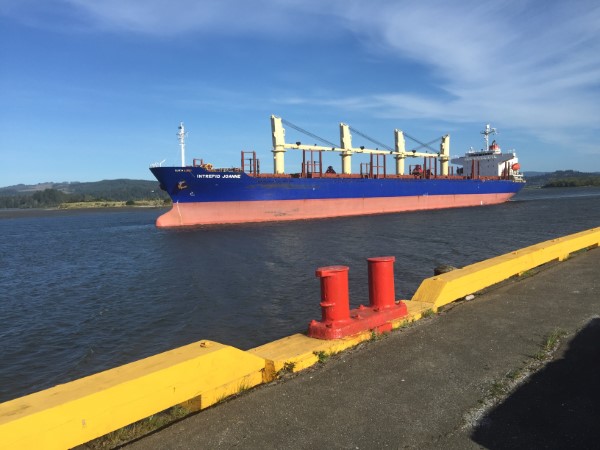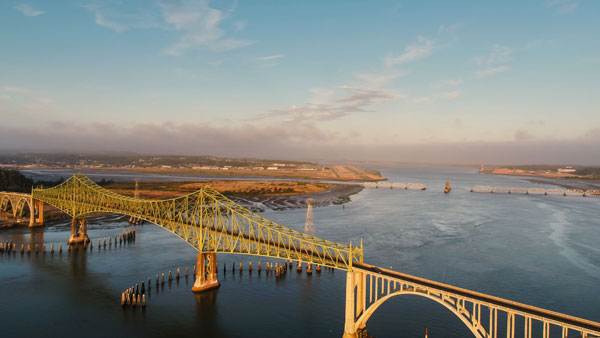When the annual blessing of the fleet occurs each spring at Charleston Marina at the Oregon International Port of Coos Bay in Oregon, a buoy bell that’s been around for 70 years rings out once for each commercial fisherman or woman who has died since 1941.
In 2021, a less dire but economically serious bell tolled when the planned $10 billion Jordan Cove LNG Terminal and Pacific Connector Gas Pipeline projects saw their authorizations vacated by the Federal Energy Regulatory Commission at the request of the projects’ owner after running into grassroots opposition and then permitting snags with the Oregon Department of Land Conservation and Development.
Today another megaproject — seeking a federal Mega-Grant from the U.S. Department of Transportation after being denied one in a previous round — stands on the starting blocks in Coos Bay. And this one appears to be all systems go.
The proposed Pacific Coast Intermodal Port (PCIP), conceptualized in 2022 after the port signed a lease agreement with NorthPoint Development, creates a new gateway for imports and exports on the West Coast that would act as a pressure release valve for congestion at other ports. The $2.3 billion project is projected to handle approximately 1.2 million containers per year and support approximately 2,500 direct jobs and 9,000 indirect jobs in Oregon. It would be the first new port on the West Coast in more than 60 years, accompanied by significant channel dredging to accommodate the world’s biggest container ships. The project received approval of $40 million in state funding in June 2023, setting the stage for potential approval of a $500 million Mega-Grant from the U.S. Department of Transportation after a previous application was denied.
The site was visited in December by Senior Advisor to the President and White House Infrastructure Implementation Coordinator Mitch Landrieu. After the visit, the Biden administration convened a federal strike force on behalf of the Port and the PCIP project, putting the project in a “strong position for success,” says John Burns, CEO of the Oregon International Port of Coos Bay. “The state has also continued to support the project with significant ongoing funding.”
 The Intrepid Joanne was one of the first ships to arrive at the terminal at Ko’Kwel Wharf in North Bend under Tribal One ownership.
The Intrepid Joanne was one of the first ships to arrive at the terminal at Ko’Kwel Wharf in North Bend under Tribal One ownership.
Photo courtesy of Tribal One
Burns says existing port users, future customers and global shipping users continue to express strong support, as do more than 150 letters of support from community stakeholders and partners. “The recent port congestion and supply chain crisis demonstrated our lack of capacity on the West Coast, which is a threat to our economy and national security,” he says. “Even before port congestion on the West Coast reached crisis levels during the COVID-19 pandemic, importers and exporters were actively seeking additional U.S. port capacity. While this congestion has briefly eased, this is only temporary. 2024 has been a stark reminder about the importance of supply chain resilience. The drought in the Panama Canal has delayed shipping and raised freight costs. At the same time, conflict in the Red Sea and reduced access to the Suez Canal are leading companies to reroute shipping around the Cape of Good Hope, adding about two weeks to shipping time while raising costs. International trade and container flows to the West Coast are projected to grow at a rapid pace well into the future. To address this growth and create resiliency, a container terminal in Coos Bay will greatly help ease future supply chain disruptions and support the long-term growth of international trade.”
I asked him how, after the disappointing Jordan Cove LNG terminal experience, the port and its stakeholders have rallied around the PCIP as the way forward.
Nearly $36.5 million in federal investments are heading to the ports of Astoria, Ko’Kwel Wharf and Newport in Oregon.
“The South Coast community has been made many promises by the government to help transition from a natural resource–based economy only to consistently be abandoned and left to fend for itself,” Burns says. “The lack of employment has led to an increasing reliance on support services which has strained under-resourced local governments who have empty coffers. The region’s biggest economic driver is currently retirement transfer payments. This demographic shift is not a sustainable model for the future.”
The PCIP project, by contrast, could sustain that future. Burns calls it “a once-in-a-generation opportunity to break this cycle of dependence by diversifying the economy and creating career-track professions that expand revenue streams. Local families have made it clear they want their kids to have the chance to stay close to home as they grow up. The region’s biggest exports have become the young people seeking employment elsewhere. There is an understanding that the future requires catalytic private-sector growth to expand opportunity throughout the region and diversify the economy.”
The Other End of Coos Bay
A 20-minute drive north of the port in North Bend sits an aging timber dock that once saw plenty of timber exports: the 30-acre Ko’Kwel Wharf property owned and operated by Tribal One, incorporated as the Mith-ih-Kwuh Economic Development Corporation, 100% owned by the 1,100-member Coquille Indian Tribe of Southwestern Oregon. On the heels of a three-year brownfields assessment supported by an EPA grant, the property that sat fallow for decades is headed toward viable reuse, supported by a $7.7 million grant awarded in November 2023 by the U.S. Department of Transportation as part of the $662 million 2023 Port Infrastructure Development Program managed by the federal Maritime Administration. The grant was part of a total of nearly $36.5 million in federal investments heading to the ports of Astoria, Ko’Kwel Wharf and Newport in Oregon.
It’s the latest phase of a gradual repurposing of more than 50 acres of industrial property acquired by the tribe in 2004 after Weyerhaeuser, after years of pleading by local economic development leaders, finally decided to sell. Twenty acres is already redeveloped as The Mill Casino Hotel and RV Park. Further redevelopment was stymied by the 2008 recession but got restarted with master planning by Tribal One in 2019, with some log exports occurring. Today Oregon Pellet Mill is constructing a pellet manufacturing and export terminal on site. The refurbishing of the wharf figures to bring that operation some neighboring employers.
The upgrade includes rehabbing 1,100 feet of dock and also bringing in 800-amp electrical service so docked vessels can use shore power. Plans are in the works for applying for another grant to study the possibility of extending the dock another 700 feet.
Ray Doering, director of public affairs and compliance for Tribal One, wrote the application for the grant. He says it’s ideal timing for a property that, thanks to mitigation ensuing from the brownfields assessment and a cleanup grant from Business Oregon, “leaves us an incredibly clean former and future industrial property.” After all, he says, “an old log dock only has a certain life expectancy.” Unlike some other Pacific Northwest ports that take a while to navigate, the Ko’Kwel Wharf is at the 11.5-mile channel marker, “so it’s easier to get in and get out,” he says. Another valuable aspect of the site is it’s “almost self-scouring” thanks to tides, meaning little need for dredging.
Doering says the Port of Coos Bay has been very cooperative with Tribal One’s own goals, and a recent upgrade of the Coos Bay Rail Line will benefit both locations’ growth plans, as one of the selling points of the region is the ability to use that rail more than trucks. “We have a rail spur already set on our property so we can bring product in by rail and of course by ocean,” Doering says. “That makes us as multimodal as they are, in a different market,” i.e. for smaller, handymax-sized ships with bulk cargoes.

